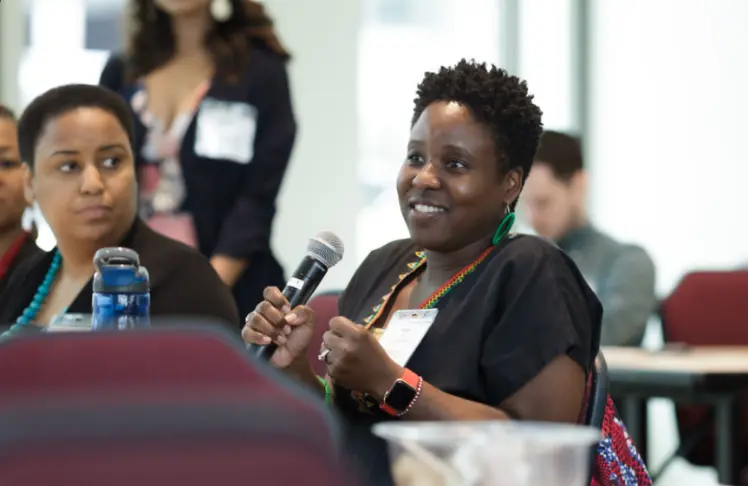
by Renata Sago
When Kerrien Suarez secured her first professional job at a global management consulting firm on the East Coast, she was one of few analysts in the office who identified as Black. This wasn’t unusual for the industry back then — or for Suarez. She had interned and attended college with mostly white people.
“In the late 90s, people weren’t talking about equity. They were talking about diversity,” she remembers. “The goal was just to have people represented at the lowest possible level” and point to that as progress.
Suarez believes that approach contributed to a “transactional representation of people” and a cycle of disparities affecting access to jobs, competitive compensation, promotion, and the demands placed on leaders of all races.
As CEO of Equity in the Center, Suarez and her team work with nonprofit and philanthropic organizations to create a race equity culture — that is, a culture in which there are no measurable disparities for race and other identities.
“Society was designed to be inequitable around race and other identities,” Suarez says. “That’s why race equity, gender equity are difficult to achieve — because society was designed to consolidate power, wealth, land, and other resources, primarily for those who identify as male and white.”
And it’s not just in the U.S., she says.
White supremacy around the world “manifests in a variety of colonial contexts,” Suarez says. “You have to intentionally dismantle the way that the system has been designed. It is possible, and it is very difficult to achieve.”
Suarez’s work comes at a time when Black job seekers have to whiten their resumes and Black employees have to code switch when dealing with colleagues. When you experience racism and bias, it can have a cumulative traumatic effect – it impacts your mental health, your physical health, your economic situation.
A Framework for Workplace Equity
In 2017, Equity in the Center collaborated with 120 experts to develop a framework called “Awake to Woke to Work” (AWW). It consists of three phases that an organization goes through as it evolves toward race equity, and seven levers within the organization that help with the process. During the “awake” phase, an organization works on becoming intentional about representing diversity; that is, seeing to it that it includes people of all races and identities in its day-to-day practices.
During the “woke” phase, the organization looks to establish a culture that values all contributions, according to the framework. This might look like pay raises, awards, and promotions aimed at achieving equity, or it could simply be balanced exchanges of ideas in meetings with diverse stakeholders.
By the “work” phase of the framework, the organization has come into complete awareness of its part in shaping and undoing inequities — within its unique culture and within its sector. According to AWW, the seven levers of influence are senior leaders, data, organizational culture, learning environment, board of directors, communities, and managers.
“The work looks different if you have a team of ten, a team of 50, a team of 100 versus a team of 200 or 400 or more,” says Suarez. “But the framework holds regardless of the organization’s size.”
According to its research, social sector organizations have the largest racial gap, with 10% of people of color in top leadership positions such as chief executive officer, \10% as board chairs, and 10% as board members. Within these organizations, senior leaders have the greatest influence, Suarez finds. They help present race equity initiatives to the public. They approve of perception and messaging. They also authorize funds for coaches, consultants, and researchers. Yet, there’s a disconnect.
“Most often in organizations when we go into them and try to support folks in navigating this work, we often hear leadership who are a barrier, ” Suarez says.
Changes in the Political Climate Are Why
What Suarez does has been the work of modern civil rights organizations since the passage of the 1964 Civil Rights Act, the 1965 Voting Rights Act, and subsequent federal legislation that contended with racial discrimination. Within the traditional corporate and philanthropic worlds, civil rights work within these organizations have been imperfect.
To Suarez, the deaths of George Floyd and Breonna Taylor, as well as repeals of affirmative action in higher education admissions and of Roe V. Wade, significantly undid years of race equity work. It has affected who gets hired, who gives money to which organizations, and how that money is allocated.
What is being asked of us is a reflection of how white supremacy operates when you try to dismantle it.
KERRIEN SUAREZ
“Black leaders are under extreme duress,” Suarez says. “Post-2020, there was an uptick in those of us who got the job to run the place. The standards for us are significantly higher, which has resulted in staff at social and racial justice organizations essentially flagellating Black- and brown-identifying leaders for not doing enough.”
These demands are coming from people who identify as Black, brown, and white, she observes.
“What is being asked of us is a reflection of how white supremacy operates when you try to dismantle it.”















